The human body often reacts violently to overload and stress, especially after 30 years. A heavy feeling in the lower back, acute back pain are all symptoms of stress or a sign of a serious illness, so you shouldn't simply ignore them. Why does my back hurt and how can I treat it?
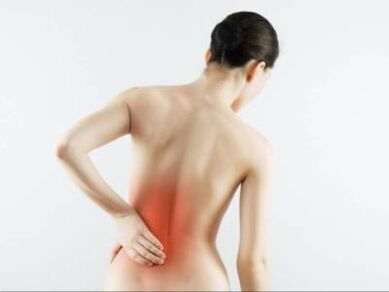
symptom
The difficulty with correct diagnosis is that many diseases can manifest in this way, and it can also be the body's response to various internal and external stimuli.
Identifying the cause of back pain and making the correct diagnosis will help to properly analyze the symptoms, which are very diverse.
Where is the waist? This is the area of the back from the coccyx to the ribs that contains many nerve endings and is divided into 2 halves by the spine.
To make a correct diagnosis, it is necessary to assess the location of the unpleasant sensation:
- Above the waist, on the right or left side - This symptom may be an indicator of inflammation of the internal organs: liver (on the right side) and kidneys (on the right or left side above the waist). They can also be caused by hepatitis, liver failure, polycystic disease, cancer, pyelonephritis. In the case of kidney inflammation, discomfort radiates to the abdomen and flanks.
- Below the waist - These symptoms are characteristic of the spine (low back pain, hernia, curvature), menstrual cramps and disorders of the female reproductive organs, inflammation of the bowel, appendix and disorders of the genitourinary system in men.
important! An unpleasant feeling in the back can be the result of inflammation and serious problems in the body.
It is also important to assess the nature of the pain sensation:
- Shooting is a symptom of a pinched sciatic nerve. As this nerve process in the back becomes inflamed, there is a burning, shooting, or tingling sensation that can vary in duration and intensity. This is especially exacerbated by changes in body position, so a person is usually limited to one position.
- Severe pain in the lower back, most commonly from shooting. Also, if a person experiences a pulling sensation in the back area and cannot move normally, choose a comfortable position. This feeling may be a symptom of: pulmonary and genitourinary disorders, disc displacement, renal colic, muscle strain.
- Chronic - persistent discomfort in the back area that goes away for a short time after taking pain medication, but then reappears. They indicate spondylosis, osteomyelitis, tumors and metabolic disorders.
- Lower back pain - comes on suddenly but lasts a long time. Weak pain is a symptom of myositis, muscle tension, or hypothermia;
- Displacement - occurs with disease of the colon, pelvic organs, pancreas or tumor.

important! A feeling of heaviness in the lower back is also a symptom of an inflammatory process in an internal organ or muscle.
If low back pain is localized to one area, chronic, and accompanied by numbness and weakness in the extremities, seek medical attention immediately.
reason
There are several different groups of reasons that can cause back pain. They are divided into natural and pathological or acquired.
Natural ones include:
- severe physical exertion - muscle tissue loses elasticity and begins to swell due to the accumulation of lactic acid;
- Sedentary work - lack of exercise, which leads to impaired circulation and a feeling of heaviness in the lower back;
- Damage to the digestive system, which can radiate to the back;
- prolonged exposure to the cold - cold temperatures cause blood vessels to constrict and slow blood flow, resulting in discomfort;
- Stress - This phenomenon can cause spasms in the muscles of the spine, resulting in pinching and discomfort.
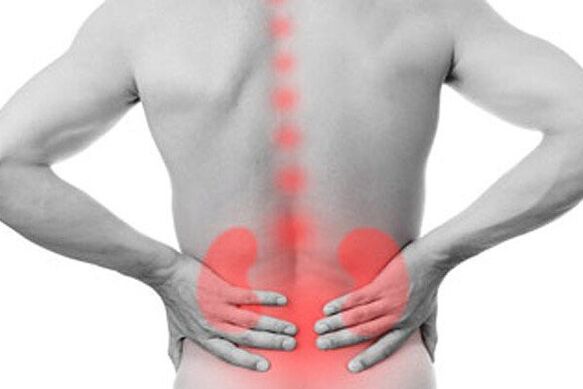
Pathological causes include:
- Diseases of the spine - negative processes in which lead to severe disease with persistent discomfort;
- Vascular disease and heart disease - if the spasm is concentrated in the shoulder blade and the area below it and is accompanied by a squeezing sensation, decreased pressure and shortness of breath, then these are symptoms of atherosclerosis and ischemia;
- Inflammation of the sciatic nerve - if there is severe pain in the lower back and a person can only be in one position, it is likely that this nerve has a cold;
- Inflammation of the urogenital system - nephritis, vaginitis, endometritis and other diseases that cause swelling of the lumbar organs and their tissues;
- muscle inflammation;
- trauma;
- Bronchopulmonary disease.
important! Because of the differences in the structure and properties of women's and men's bodies, their back pain can be a symptom of a completely different process.
Low back pain in men may be related to:
- kidney disease;
- reproductive system problems;
- consequences of trauma.
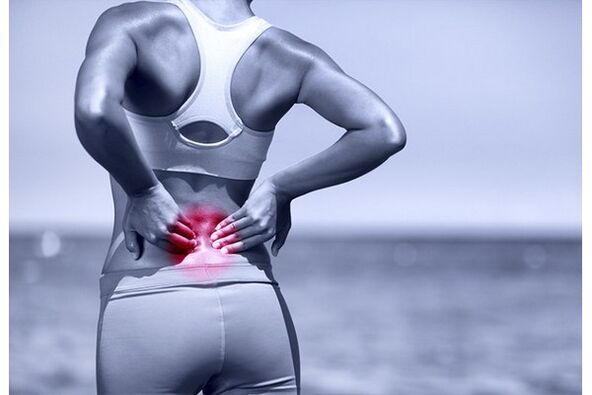
Low back pain is common in men over the age of 35 because they are at risk at this age, so you should contact the clinic if you have the mildest symptoms. The risk group also included the following men:
- engage in manual labor;
- lead a sedentary lifestyle;
- being overweight and having bad habits;
- Weak immunity.
Which doctor should I contact with questions? The first is the therapist, who, after receiving the initial data and analysis, sends the patient to an infectious disease specialist, gastroenterologist, cardiologist, urologist, nephrologist, neuropathologist, or proctologist.
Women also often have low back pain, but the causes can be quite different from men.
There is no single answer, it could be:
- PMS or cramps during menstruation - due to delay, hormone exhaustion, uterine contractions, tension and swelling of genitourinary tissues, pelvic tension and lower back pain.
- Pregnancy - Due to weight gain, there is increased pressure on a woman's spine, which causes tension in a woman's lower back. It's worth mentioning that in the early stages, heaviness and pain in the lower back can be a sign of a miscarriage threat, so seek immediate medical attention if it occurs;
- Postpartum - If a girl has spinal problems before childbirth, they don't go away after childbirth, but are specific, instead exacerbated by possible displacement or squeezing of the discs.
- Gynecological diseases - lower back pain in women, with all inflammatory processes in the organs of the genitourinary system, occurs regardless of the load. There is heaviness and soreness in the lower back due to them. If you have acute pain in your lower back, this is a symptom of a ruptured ovary or an ectopic pregnancy.
- Internal organs and spine problems.
The female risk group includes the following women:
- have genitourinary infection;
- intestinal instability;
- have tumor disease;
- sedentary work;
- Complications after a cold;
- physiological changes;
- excessive physical activity;
- weight gain;
- Past experience with epidural anesthesia.
In addition to diseases and inflammatory processes in the body, there are many stimuli for low back pain:
- low temperature;
- A sedentary lifestyle and infrequent physical activity;
- excessive physical activity;
- Professional sports, bodybuilders, bodybuilders, weightlifters should be especially careful.
If you belong to one of these risk groups, you should exercise regularly under the supervision of a qualified trainer and be observed by a doctor to take precautions to prevent back problems.
treat
If back problems are already present, preventive measures will not help. You should consult your doctor to find out the exact cause and start treatment. You can use the methods of traditional medicine or turn to traditional methods, but any action should be done with the consent of your doctor. Which doctor should I contact? First, a therapist, and after finding out the cause - a narrow specialist.
folk remedies
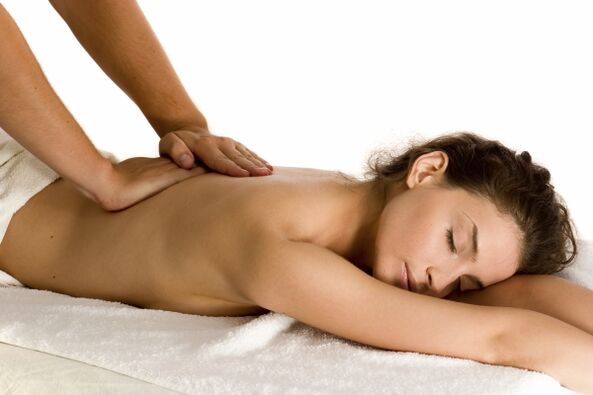
Traditional medicine involves the use of several methods of struggle:
- Massage - Massaging a stiff back can help relieve tension and swelling. You can do a self-massage or you can contact a specialist, but only a verified specialist so he doesn't exacerbate problems that are already there.
- Physical Activity - Do regular exercise and warm-ups during the day to relax your muscles and relieve muscle tension.
- Compresses - To relieve tissue swelling, compresses should be made with cabbage, burdock leaves, and plantain. After putting them on and wrapping your back in a warm scarf, you should lie down and rest for half an hour.
Traditional medicine can also be used as a way to prevent serious problems. However, if back pain in the lower back increases and is not relieved by massage, compression, and exercise, you should consult a therapist immediately.
contact doctor
If the discomfort and soreness in the lower back does not go away, and traditional medicine and massage do not help, how can it be treated? First, you should consult a therapist and find out why. For diagnosis, the back is examined in a number of ways:
- X-rays are taken to check for injuries.
- Ultrasound is done to rule out disease and inflammation of the internal organs. For this purpose, MRI with CT can also be performed.
- General and Biochemical Analysis.
- An electrocardiogram and gastroscopy were performed to rule out heart and gastrointestinal disorders.
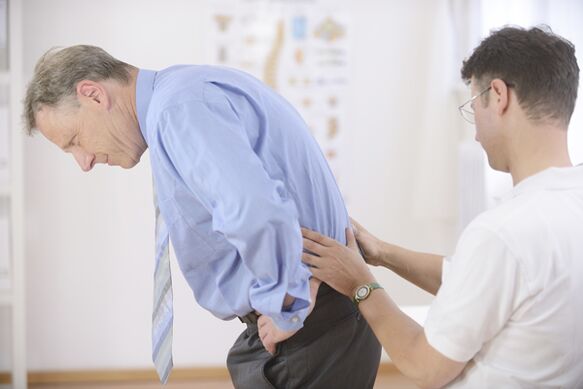
After an accurate diagnosis is established, the patient is prescribed appropriate treatment:
- Problems with the spine, joints and muscles are treated with non-steroidal medications, therapeutic exercises and massage sessions;
- Treat cardiovascular disease by limiting physical activity and prescribing appropriate medications;
- Digestive tract disease means sticking to a strict diet and a regimen of drugs that wrap the gut;
- Treat bronchopulmonary disease with antibacterial and antiviral drugs;
- Pelvic organ problems - antimicrobials and physical therapy.
In addition, preventive work should also be done:
- not bearing weight;
- keep your back straight at all times;
- sleeping on a firm mattress;
- Avoid hypothermia, stress and overeating;
- Treat acute illnesses promptly.
Back pain is easy to prevent with prompt prevention: a proper lifestyle, regular moderate exercise - all of which will help prevent back problems and ease existing ones.


















